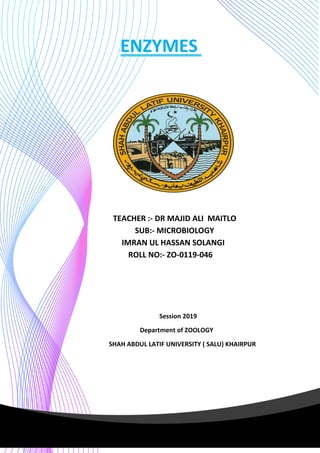
Enzymes
- 1. ENZYMES TEACHER :- DR MAJID ALI MAITLO SUB:- MICROBIOLOGY IMRAN UL HASSAN SOLANGI ROLL NO:- ZO-0119-046 Session 2019 Department of ZOOLOGY SHAH ABDUL LATIF UNIVERSITY ( SALU) KHAIRPUR
- 2. Contents: Enzymes Energy of Activation Characteristics of Enzymes Classification of enzymes Mode of Action Factors Affecting Enzymes Activity Uses of enzymes
- 3. Enzymes ENZYMES(BIO-CATALYSTS) Enzymes are bio-catalyst which speed up the chemical reactions by lowering “Energy of activation”. NOMENCLATURE OF ENZYMES Enzyme is a Greek word means-En(in) and Zyme(yeast). DISCOVERY OF ENZYME Term “Enzyme” was coined by F.W Kuhne in 1978. NATURE OF ENZYME Almost all enzymes are protein in nature except few which are nitrogenous acids like RNA-DNA(Ribozymes). Ribozymes catalyze reactions in genetic informations. Energy of Activation Amount of energy which is required to start a chemical reaction. OR Energy required to break a (particular covalent) bond present in reactant.
- 4. CHARACTERISTICS OF ENZYMES Protein in nature and are formed by living cells. May be intracellular or extra cellular. Remains unchanged during and after the reaction. Speed up the rate of reaction by decreasing energy of action. Specific in their nature. Heat sensitive and act on particular (optimum) temp. Each has specific substrate pH for its activity. Action can be alter by activators and inhibitors. Classification of enzymes (on the basis of functions) (1) OXIDOREDUCTASE Catalyze reactions in which one substrate is oxidized while other is reduced. Sub classes are: Dehydrogenases(convert single bond to double bond) Oxidases (use oxygen as oxidant) Peroxidases (use H202 as oxidant) Hydroxylases (introduce hydroxyl group) Oxygenases (introduce mol. Oxygen in place of double bond). (2) TRANSFERASES Transfer one carbon group (e.g. methyl) from one substrate to another substrate. (3) HYDROLASES Catalyze hydrolytic cleavage of C-O, C-N, C-C and P-O bonds and other single bonds (e.g. Peptidases, Esterases, Glycosidases and Phosphatidases). (4) LYASES Catalyze Elimination reactions to form double bond and reversible reaction by adding groups across double bond (e.g. Decarboxlases, Aldolases and Dehydratases). (5) ISOMERASES They alter the structure but not the atomic composition by moving a group from one position to another in one molecule (e.g. Epimerases, Mutases). (6) LIGASES Catalyze reaction in which two molecules are joined. They are also known as synthtases.
- 5. MODE OF ACTION OF ENZYMES 1- The action of enzyme depends on its chemical structure. A typical enzyme molecule, has “3D” structure. 2- Has depression or pit for substrate (to fit in) known as “Active site”. 3- Any other site other than active site is called “Allosteric site” There are two theories in respect of enzyme action, which are as follows. LOCK AND KEY MODEL Proposed by Fischer (1898) and modified by Paul Filder and D.D Woods according to this model, The active site of enzyme has distinct shape. It allows few substrate to fit in (like a particular lock allows particular key to fit in) Enzyme breaks substrate to product INDUCE FIT MODEL Proposed by koshland (1959), it states that Enzyme binds with a substrate This binding induce changes in enzyme structure Due to this change enzyme acts and forms product
- 6. Factors Affecting Enzymes Activity FACTORS AFFECTING ENZYME ACTIVITY The activity of enzymes depend on following factors, 1. SUBSTRATE CONCENTRATION Increases with increase in substrate concentration (up to a limit) At very high concentration, activity again decreases due to saturation of enzyme with substrate and saturation of product i.e. higher concentration of product. 2. TEMPERATURE Increases with in temperature(up to limits) Maximum activity at optimum temperature. Highly active at 37˚C and destroyed at 100˚C At 0˚C minimum activity. 3. PH Enzymes are pH specific i.e. work in specific pH(because of protein can act both in acidic and basic medium. 4. WATER Enzyme activity is usually maximum (up to limits) but decrease after limits (dilution of enzyme) 5. RADIATIONS Enzymes become inactive due to radiations (including Alpha, Beta, Gamma rays). 6. CO-ENZYME AND ACTIVATORS Induce the enzyme activity. INHIBITORS Substances which decreases the activity of enzymes. COMPETITIVE INHIBITORS Inhibitor molecules which resemble the normal substrate molecule and compete for admission into the active site. They block the substrate from entering active site. NON-COMPETITIVE INHIBITORS Inhibitors bind to a part of the enzymes away from the active site (Allosteric
- 7. site). This binding cause change in the enzyme molecule shape and decrease in enzyme activity. FEED BACK INHIBITION Common biological control mechanism of brain in order to regulate enzyme activity. PROSTHETIC GROUP Non-protein part of enzyme (Co-enzyme or Co-factor) CO-ENZYME When prosthetic group consist of organic molecules (like FAD/NAD) CO-FACTORS/ACTIVATORS When prosthetic group consist of inorganic molecules (like Ca++, Na+ etc). APOENZYME Protein part of enzyme. Uses of enzymes i. ELISA: It is enzyme based detection of diseases like AIDS. ii. Endonucleases: They are enzymes used in breaking DNA at specific sites. DNA fragments are employed in genetic engineering. iii. Alcoholic Beverages: Enzyme complex zymase obtained from yeast is used in brewing or fermentation of alcoholic drinks. iv. Detergents: They contain protease for brighter washing of clothes and amylase for dish washing.
- 8. v. Baby Foods: Trypsin is added to partially pre-digest baby foods. vi. Strep tokinase: The enzyme is used in clearing blood clots inside blood vessels. vii. Digestive Aids: Diastase and other enzymes are used regularly by patients with deficient digestive juices. viii. Cheese: Rennet or rennin tablets are used for preparation of cheese. Lactase and lipase are employed to provide proper ix. Pectinase: It is used for clearing fruit juices, rettingof fibres and preparation of green coffee. x. Protease: The enzyme is employed for chill proofing of beverages, degumming of silk, cleaning of hides, softening of bread and meat.